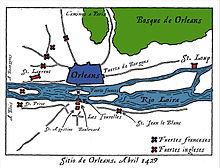Siege of Orléans
![]()
This article or section is still missing the following important information:
The part of the siege before the arrival of Jeanne d'Arc needs to be added to.
Help Wikipedia by researching and adding them.
Siege of Orléans
Part of: Hundred Years War

Siege of Orléans
Battles of the
Hundred Years War
(1337-1453)
Phase 1 1337-1386
Channel and Flanders (1337-1340): Cadzand - Arnemuiden - Channel - Sluis
Chevauchées of the 1340s: Saint-Omer - Auberoche
Edward III campaign (1346/47): Caen - Blanchetaque - Crécy - Calais
War of the Breton Succession (1341-1364): Champtoceaux - Brest - Morlaix - Saint-Pol-de-Léon - La Roche-Derrien - Tournament of the Thirty - Mauron - Auray.
France's Allies: Neville's Cross - Les Espagnols sur Mer - Brignais
Chevauchées of the 1350s: Poitiers
Castilian Civil War & War of the Two Peter (1351-1375): Barcelona - Araviana - Nájera - Montiel
French counter-offensive: La Rochelle - Gravesend
Wars between Portugal and Castile(1369-1385): Lisbon - Saltés - Lisbon - Aljubarrota
2nd phase 1415-1435
Henry V campaign (1415): Harfleur - Azincourt
Battle for Northern France: Rouen - Baugé - Meaux - Cravant - La Brossinière - Verneuil
Joan of Arc and the turn of the war: Orléans - Battle of the Herrings - Jargeau - Meung-sur-Loire - Beaugency - Patay - Compiègne - Gerberoy
Phase 3 1436-1453
French victory: Formigny - Castillon
The siege of Orléans by the English in the Hundred Years' War began on 7 October 1428 and ended on 8 May 1429; it is considered the turning point of the war. The victory brought the crossing of the Loire back into French hands and opened the way for the French king Charles VII to be crowned in Reims Cathedral.
History
Since 7 October 1428, the city of Orléans was besieged by English (and initially also Burgundian) troops. However, they did not succeed in completely closing the ring around the city. From the northeast and east it was still possible to reach Orléans in some places. However, larger food transports, which would have been necessary to supply the large city, were hardly possible. On February 12, 1429, an attempt to stop an English supply convoy bringing mainly salted herring to the besiegers had failed. Since this "Herring Day" the situation of the city seemed more and more hopeless (see: Battle of the Herrings).
On 29 April 1429, Joan of Arc, coming from Chinon, arrived in Orléans accompanied by her brothers Jean and Pierre and a few other men. Joan of Arc initially met with little approval from the French commanders stationed in Orléans, who would not listen to a woman. Her efforts to peacefully persuade the English to withdraw from Orléans with messages were dismissed as ridiculous. When this happened, Joan of Arc earned the ridicule of the English, who also captured the heralds, even though this was against the laws of war at the time.
This was followed by attacks on the English forts. The first attack began unplanned, as a small skirmish. It involved the French knight Étienne de Vignolles, called La Hire ("the Angry One") for his outbursts of rage, and Joan of Arc. Joan of Arc did not fight in the front line, as she was not a trained fighter, unlike the knights, and was also of rather diminutive stature; but she apparently took part in the fighting (contrary to the claims of some saints' books).
On 4 May the only English bastion on the east side of the town, Saint-Loup, was taken by the French; this was the first French success for several months. After a one-day pause on Ascension Day, fighting resumed on 6 May, with the result that the English retreated to the fortress of Les Tourelles, abandoning the other forts south of the Loire. On the following day, 7 May, the French also succeeded in storming the Tourelles. Joan of Arc was wounded by an arrow in the process. As the English retreated from the fortress, the burning bridge collapsed under the English commander Glasdale. Unable to dispose of his armour, he drowned in the Loire. The siege was now lifted on the east and south of the city. On 8 May, a Sunday, the two armies still faced each other, ready to fight, for about an hour; neither side, however, began the fight - whether for tactical or religious reasons (no fighting was actually allowed on Sunday). Finally, the English army retreated; the siege of Orléans was over.

Siege of Orléans 1429 with the fortifications

Orléans 1428 with Les Tourelles in the foreground
See also
- Battle of the Herrings
Search within the encyclopedia